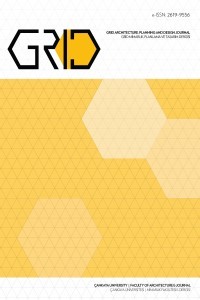Bağlantısal bir okuma yöntemine doğru: Bir mimari sözlüğün zamansallığı üzerine
Süre, Zamansallık, Bağlantısallık, Mimari sözlük, Mimari araştırma
Towards an interconnected reading method: Temporality of an architectural lexicon
___
- Baek, J. (2010). Emptiness and empty cross: Tadao Ando's Church of Light. Center: Architecture & Design in America, 15, 1-14.
- Bergson, H. (2002). Duration and simultaneity. In K. Ansell Pearson, & J. Mullarkey (Eds.), Henri Bergson: Key writings (pp. 203-219). Continuum.
- Bergson, H. (2007). Madde ve bellek. (I. Ergüden, Trans.) Dost. (Original work published 1939)
- Bergson, H. (2013). Time and free will: An essay on the immediate data of consciousness. Routledge. (Original work published 1910)
- Burge, T. (1993). Concepts, definitions, and meaning. Metaphilosophy, 24(4), 309-325. https://doi.org/10.1111/j.1467-9973.1993.tb00198.x
- Colebrook, C. (2002). Gilles Deleuze. Routledge.
- Deleuze, G. (1988). Bergsonism. (H. Tomlinson, & B. Habberjam, Trans.) Zone Books. (Original work published 1966)
- Deleuze, G. (1989). Cinema 2: The Time-Image. (H. Tomlinson, & R. Galeta, Trans.) University of Minnesota Press. (Original work published 1985)
- Deleuze, G. (2000). Proust and Signs. (R. Howard, Trans.) University of Minnesota Press. (Original work published 1964)
- Deleuze, G. (2005). Bergsonculuk. (H. Yücefer, Trans.) Otonom. (Original work published 1966)
- Deleuze, G. (2013). Müzakereler. (I. Uysal, Trans.) Norgunk. (Original work published 1990)
- Eco, U. (2016). Açık yapıt (3rd ed.). (T. Esmer, Trans.) Can. (Original work published 1962)
- Ekmekci Geronymakis, T. O. (2021). Designing an interconnected lexicon on void to support an open-ended architectural vocabulary. Retrieved from RSD10 Relating Systems Thinking and Design Symposium: https://rsdsymposium.org/designing-an-interconnected-lexicon-on-void-to-support-an-open-ended-architectural-vocabulary/
- Ekmekci Geronymakis, T. O. (2021-present). Architectural lexicon on void: An experiment on designing an interconnected reading method [Digital lexicon]. https://www.lexicononvoid.org/
- Ekmekci Geronymakis, T. O. (2022, May 17). Architectural lexicon on void- Exploring different layers [Video]. https://youtu.be/oa8lf5mqMHQ
- Elman, J. L. (2004). An alternative view of the mental lexicon. Trends in Cognitive Sciences, 8(7), 301-306. https://doi.org/10.1016/j.tics.2004.05.003
- Erzen, J. N. (2017). Derin Önceliklerin ve Tinselin Mimarı Louis I. Kahn. In N. M. Cengizkan (Ed.), Louis Kahn’a Yeni/Den Bakış = Re/Framing Louis Kahn (pp. 285-328). Pera Müzesi
- Gadamer, H. G. (2006). Truth and method (2nd ed.). (J. Weinshei, & D. G. Marshall, Trans.) Continuum. (Original work published 1975)
- Grosz, E. (1997). The future of space: Toward an architecture of invention. ANY: Architecture New York, 19/20, 19.12-19.15.
- Kahn, L. (2017). Silence and Light. In N. M. Cengizkan (Ed.), Louis Kahn’a Yeni/Den Bakış = Re/Framing Louis Kahn (pp. 33-52). Pera Müzesi. (Original work published 2003)
- Kılıç, T. (2019a). A brain inspired view of life: The scientific, social and cultural implications of interconnectivity and complexity. 2019 IEEE 18th International Conference on Cognitive Informatics & Cognitive Computing (ICCI*CC), (pp. 97-102). https://doi.org/10.1109/ICCICC46617.2019.9146063
- Kılıç, T. (2019b, November 30). Yeni Bilim ve Kültürün Kaynağı: Bağlantısal Bütünsellik [Seminar video]. Youtube. https://www.youtube.com/watch?v=rLu2zXWvAX8
- Lapoujade, D. (2006). Deleuze’ün başkaldıran yapısalcılığı/ Le structuralisme dissident de Deleuze. In A. Akay (Ed.), Gilles Deleuze için/ Pour Gilles Deleuze (pp. 15-37). Akbank Sanat.
- Maulden, R. (1986). Tectonics in architecture: from the physical to the meta-physical [Master's thesis, MIT]. Retrieved from DSpace@MIT: http://dspace.mit.edu/handle/1721.1/78804
- Oxford University. (2021). Encounter (noun). In Lexico.com dictionary. Retrieved May 16, 2022, from https://www.lexico.com/definition/encounter
- Oxford University. (2021). Full. In Lexico.com dictionary. Retrieved May 16, 2022, from https://www.lexico.com/definition/full
- Oxford University. (2021). Void (noun). In Lexico.com dictionary. Retrieved May 10, 2022, from https://www.lexico.com/definition/void
- Snodgrass, A. (2004). Thinking through the gap: The space of Japanese architecture. Architectural Theory Review, 9(2), 65-85. https://doi.org/10.1080/13264820409478518
- Sporns, O. (2012). Discovering the human connectome. The MIT Press.
- van Schaik, L. (2008). Spatial intelligence: New futures for architecture. John Wiley & Sons.
- Zabunyan, D. (2006). Deleuze, sinema ve “felsefi üçlem”/ Deleuze, le cinéma et la “trinité philosophique". In A. Akay (Ed.), Gilles Deleuze için/ Pour Gilles Deleuze (pp. 39-45). Akbank Sanat.
- Yayın Aralığı: Yılda 2 Sayı
- Başlangıç: 2017
- Yayıncı: Çankaya Üniversitesi
Su tasarruflu peyzaj tasarımı olarak “Kurakçıl Peyzaj”: Arizona Eyalet Üniversitesi Tempe Kampüsü
Geç Modern Dönem konut mimarlığında çiçekliklerin cephe dilindeki yeri: Bağdat Caddesi apartmanları
Kültür varlıklarının cephe ve siluet aydınlatmaları: uygulamalar, gereklilikler ve öneriler
Bağlantısal bir okuma yöntemine doğru: Bir mimari sözlüğün zamansallığı üzerine
Türkan Oya EKMEKCİ GERONYMAKİS, Ayşe ŞENTÜRER
Türkan KEJANLI, Canan KOÇ, Muhammet Can ALKAN
Adana’nın Kentsel Ayrışma Monografisi: Endeks Temelli Bir Yaklaşım
Ela ATAÇ KAVURMACI, İnan Utku TÜRKMEN
Yenişehir’in kayıp mekânı: Millet Meydanı
Can GOLGELİOGLU, Deniz ALTAY KAYA, Damla YEŞİLBAĞ
“Mekân, Yer ve Yer Kaybı” kavramlarının örnekler üzerinden değerlendirilmesi
Gamze AKBAŞ, Fatma Gül ÖZTÜRK BÜKE
Anadolu’daki kale-kentlerin karşılaştırmalı morfolojik analizi
